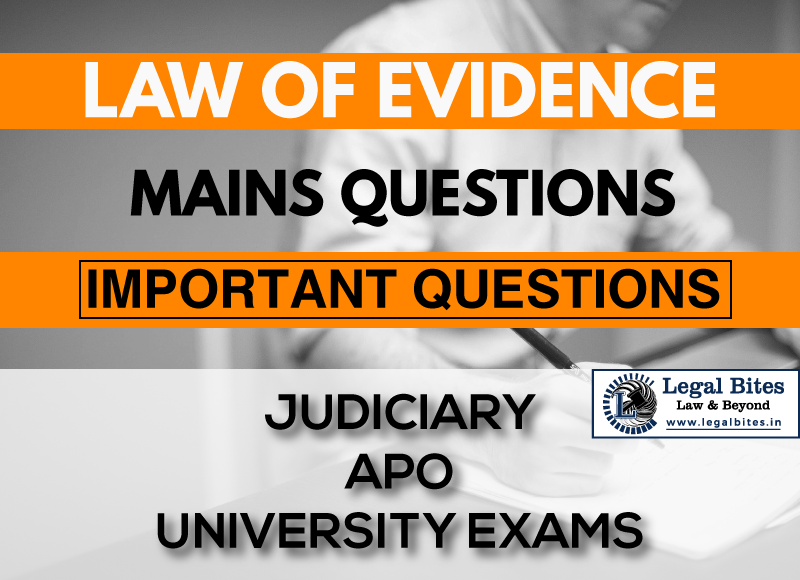At the trial of A for the murder of her husband B by administering arsenic to him, evidence is offered to show that A and B used to have frequent quarrels. Discuss fully whether the evidence offered is admissible?
Question: At the trial of A for the murder of her husband B by administering arsenic to him, evidence is offered to show that A and B used to have frequent quarrels. Discuss fully whether the evidence offered is admissible? [U.P.C.J. 1999, BIHAR J. 1997, HR.J.S. 1998] Find the answer to the mains question only on Legal Bites.… Read More »

Question: At the trial of A for the murder of her husband B by administering arsenic to him, evidence is offered to show that A and B used to have frequent quarrels. Discuss fully whether the evidence offered is admissible? [U.P.C.J. 1999, BIHAR J. 1997, HR.J.S. 1998] Find the answer to the mains question only on Legal Bites. [At the trial of A for the murder of her husband B by administering arsenic to him, evidence is offered to show that A and B used to have frequent quarrels. Discuss...
Question: At the trial of A for the murder of her husband B by administering arsenic to him, evidence is offered to show that A and B used to have frequent quarrels. Discuss fully whether the evidence offered is admissible? [U.P.C.J. 1999, BIHAR J. 1997, HR.J.S. 1998]
Find the answer to the mains question only on Legal Bites. [At the trial of A for the murder of her husband B by administering arsenic to him, evidence is offered to show that A and B used to have frequent quarrels. Discuss fully whether the evidence offered is admissible?]
Answer
Section 8 of the Indian Evidence Act deals with when motive, preparation, and previous or subsequent conduct of the parties become relevant.
Motive is that which moves a man to do a particular act. There can be no action without a motive, which must exist for every voluntary act. Generally speaking, the voluntary acts of sane persons have an impelling emotion or motive. The motive in the correct sense is the emotion supposed to have led to the act. It is often proved by the conduct of a person.
In the case of State of UP v. Babu Ram, AIR 2000 SC 1735 in which an explanation of the role of motive that the accused asked for partition of landed property which the deceased was resisting, any false explanations by accused persons are relevant. The court observed that the ordinary feelings, passions, and propensities under which parties act, are facts known by observation and experience; and they are so uniform in their operation that a conclusion may be safely drawn that, if a party acts in a particular manner, he does so under the influence of a particular motive.
Also, previous threats, previous altercations, or previous litigations between parties are admitted to show motive as held in Chhotka v. State of West Bengal, AIR 1958 Cal 482. However, the mere existence of the motive is by itself not an incriminating circumstance. Motive, however strong, cannot take place of proof. The motive for the commission of an offence is of particular importance only in cases of purely circumstantial evidence for, in such cases, motive itself would be a circumstance that the court would have to consider.
Therefore, at the trial of A for the murder of her husband B by administering arsenic to him when evidence is offered to show that A and B used to have frequent quarrels, such evidence can be relevant by virtue of section 8 of the IEA as B could have a motive behind the commission but this is only an inference based on circumstantial evidence and not a proof. Thus, the evidence against B though relevant cannot be made admissible in the court.
Important Mains Questions Series for Judiciary, APO & University Exams
- Law of Evidence Mains Questions Series Part-I
- Law of Evidence Mains Questions Series Part-II
- Law of Evidence Mains Questions Series Part-III
- Law of Evidence Mains Questions Series Part-IV
- Law of Evidence Mains Questions Series Part-V
- Law of Evidence Mains Questions Series Part-VI
- Law of Evidence Mains Questions Series Part-VII
- Law of Evidence Mains Questions Series Part-VIII
- Law of Evidence Mains Questions Series Part-IX
- Law of Evidence Mains Questions Series Part-X
Admin Legal Bites
Legal Bites Study Materials correspond to what is taught in law schools and what is tested in competitive exams. It pledges to offer a competitive advantage, prepare for tests, and save a lot of money.
